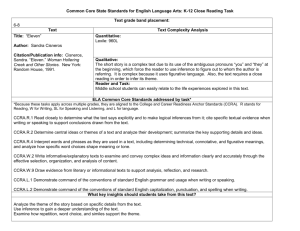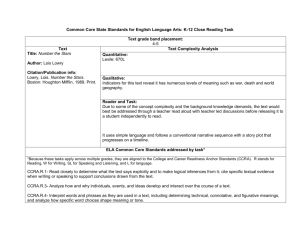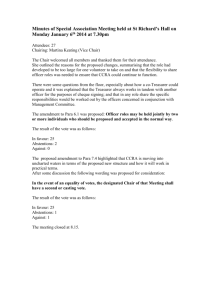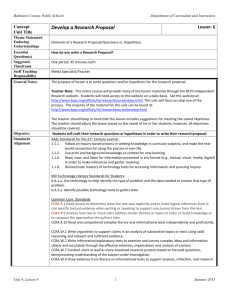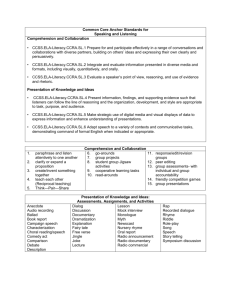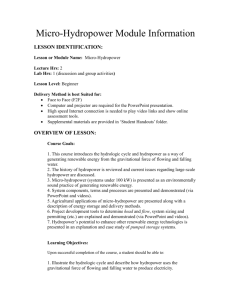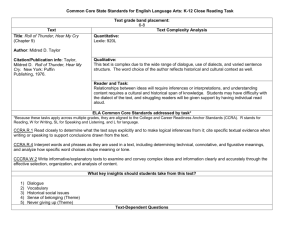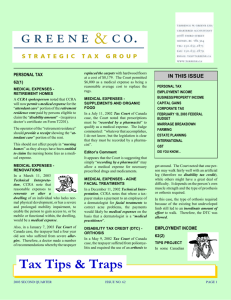Tax Tips & Traps 50 - Kiel & Company Chartered Accountant
advertisement
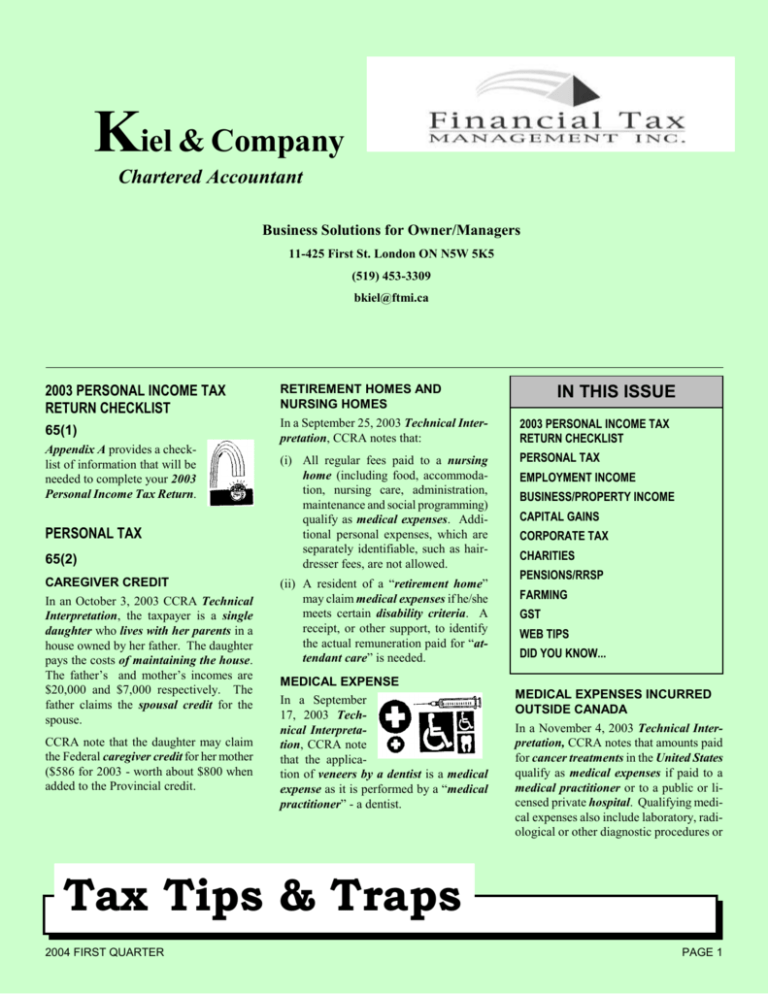
Kiel & Company Chartered Accountant Business Solutions for Owner/Managers 11-425 First St. London ON N5W 5K5 (519) 453-3309 bkiel@ftmi.ca 2003 PERSONAL INCOME TAX RETURN CHECKLIST 65(1) Appendix A provides a checklist of information that will be needed to complete your 2003 Personal Income Tax Return. PERSONAL TAX 65(2) CAREGIVER CREDIT In an October 3, 2003 CCRA Technical Interpretation, the taxpayer is a single daughter who lives with her parents in a house owned by her father. The daughter pays the costs of maintaining the house. The father’s and mother’s incomes are $20,000 and $7,000 respectively. The father claims the spousal credit for the spouse. CCRA note that the daughter may claim the Federal caregiver credit for her mother ($586 for 2003 - worth about $800 when added to the Provincial credit. RETIREMENT HOMES AND NURSING HOMES In a September 25, 2003 Technical Interpretation, CCRA notes that: (i) All regular fees paid to a nursing home (including food, accommodation, nursing care, administration, maintenance and social programming) qualify as medical expenses. Additional personal expenses, which are separately identifiable, such as hairdresser fees, are not allowed. (ii) A resident of a “retirement home” may claim medical expenses if he/she meets certain disability criteria. A receipt, or other support, to identify the actual remuneration paid for “attendant care” is needed. MEDICAL EXPENSE In a September 17, 2003 Technical Interpretation, CCRA note that the application of veneers by a dentist is a medical expense as it is performed by a “medical practitioner” - a dentist. IN THIS ISSUE 2003 PERSONAL INCOME TAX RETURN CHECKLIST PERSONAL TAX EMPLOYMENT INCOME BUSINESS/PROPERTY INCOME CAPITAL GAINS CORPORATE TAX CHARITIES PENSIONS/RRSP FARMING GST WEB TIPS DID YOU KNOW... MEDICAL EXPENSES INCURRED OUTSIDE CANADA In a November 4, 2003 Technical Interpretation, CCRA notes that amounts paid for cancer treatments in the United States qualify as medical expenses if paid to a medical practitioner or to a public or licensed private hospital. Qualifying medical expenses also include laboratory, radiological or other diagnostic procedures or Tax Tips & Traps 2004 FIRST QUARTER PAGE 1 services. Also, an individual may claim transportation and travel expenses if substantially equivalent medical services are not available in the individual’s locality. MEDICAL EXPENSE - HOME CONSTRUCTION COSTS In a July 28, 2003 Tax Court of Canada case, the taxpayer had multiple sclerosis (M.S.) and, in the construction of a new home, incurred costs of $15,125 for items such as wider passageways, an elevator shaft, dugout to create walkout access, wider stairs, lower windows for viewing, and appropriate kitchen and vanity design. The Court permitted these expenses as medical expenses. PHARMACIST - MEDICAL PRACTITIONER In a December 2, 2003 Technical Interpretation, CCRA notes that they have reviewed the legislation in each jurisdiction in Canada and are satisfied that an amount paid by an individual to a pharmacist in respect of a “medical service” qualifies as a medical expense. LATE FILING PENALTIES The Income Tax Act has a first offense late filing penalty of 5% of the tax unpaid plus 1% per month to a maximum of twelve months for a total of 17%. This penalty is in addition to interest on the amounts due. If there are no taxes owed there will be no late filing penalty. However, if the taxpayer has been charged with a late filing penalty in any of the three preceding taxation years, the late filing penalty can be doubled on the second offence to 10% of the tax owing plus 2% per month for a maximum of up to 20 months for a total of 50%. EMPLOYMENT INCOME 65(3) THE $500 GIFT AND $500 AWARDS PLAN In a September 25, 2003 Technical Interpretation, CCRA note that employers may give, on a tax deductible basis, two noncash gifts per year tax-free to an employee for special occasions such as Christmas, Hanukkah, birthday, marriage or a similar event where the aggregate of the gifts is not more than $500 per year. Similarly, employers may give two non-cash awards per year on a tax-free basis in recognition of special achievements such as reaching a set number of years of service, or meeting or exceeding safety standards. The total cost of the awards must not be greater than $500 per year. EMPLOYMENT INSURANCE (EI) In an October 8, 2003 Technical Interpretation, CCRA notes that related persons and non-arm’s length non-related persons may be exempt from EI even though they own less than, or equal to, 40% of a voting class of shares. HUMAN RIGHTS VIOLATION In an October 16, 2003 Technical Interpretation, CCRA notes that a settlement with an employee for a human rights violation is a tax-free receipt. The Human Rights Code states that a person must not refuse to employ or, continue to employ, a person, or discriminate against a person regarding employment or any term or condition of employment because of their race, colour, ancestry, place of origin, political belief, religion, marital status, family status, physical or mental disability, sex, sexual orientation or age of that person or, because that person has been convicted of a criminal or summary conviction offense that is unrelated to the employment or to the intended employment of that person. EMPLOYER-PAID GYM MEMBERSHIPS In an October 17, 2003 Technical Interpretation, CCRA notes that generally the payment or reimbursement of club dues or membership fees by an employer is a taxable benefit to the employee. However, if it is clearly to the employer’s advantage for the employee to be a member of a club, the employee will not have a taxable benefit. Editor’s Comment If the membership is to further the business aspects of the employer, such as the employee mixing with current and potential customers, it would seem arguable that there is no taxable benefit if the employer is the primary beneficiary of the advantage. BUSINESS/PROPERTY INCOME 65(4) SCIENTIFIC RESEARCH AND EXPERIMENTAL DEVELOPMENT (SR&ED) In two studies by consultants KPMG Chartered Accountants it was noted that many firms which are eligible for SR&ED are not making the claims, either because they have had bad experiences in the past with detailed audits and questions, or they have heard of bad experiences or, they are not aware, of the SR&ED credit (35% refundable investment tax credit for Canadian-controlled private corporations and 20% for others). It is important to note that CCRA has simplified the process, assists companies that wish to make claims, and expedites Tax Tips & Traps 2004 FIRST QUARTER PAGE 2 the refunds. Therefore, this is an important area, especially for companies that are in the high tech industry or manufacturing. DAMAGE PAYMENTS In an October 30, 2003 Technical Interpretation, CCRA notes that a damage payment is deductible as a current expense if it is incurred to earn income from a business or property, it is not on account of capital, it is not related to a personal expense and the amount is reasonable. In a November 5, 2003 Technical Interpretation, CCRA notes that where a business makes a damage payment for breach of contract in the course of an ongoing business, the payment would normally be currently deductible. RESERVE DEDUCTIONS The Income Tax Act permits a taxpayer to claim a reserve deduction on a business inventory sale for proceeds which are not due at the yearend. The reserve is limited to three years. The Income Tax Act also permits a taxpayer to claim a reserve deduction for services to be rendered after the end of the year. However, this does not include a reserve in respect of guarantees, indemnifications or warranties. PET EXPENSES In a November 20, 2003 Technical Interpretation, CCRA note that it is possible to deduct the portion of pet expenses that are related to earning income. However, in some cases this may require a pro-ration between “personal” and “business”. CAPITAL GAINS 65(5) NON-COMPETITION PAYMENTS In response to a recent Federal Court of Appeal Decision, the Department of Finance introduced, effective October 7, 2003, amendments to the Income Tax Act to treat non-compete receipts as regular income, or in certain circumstances as a capital gain or an eligible capital receipt - but not tax free. The payment will be considered an eligible capital expenditure or a capital amount. Income Tax Act to limit the tax benefits of certain charitable donations made under tax shelter and other arrangements. CORPORATE TAX These proposals will not apply to gifts of publicly traded securities, certified cultural property, ecological gifts, or real property situated in Canada. 65(6) CORPORATE INTERNET FILING CCRA now permits corporate internet filing for corporate federal income tax returns. (T2 Form) For further information on corporate internet filing see http://www.ccra-adrc.gc.ca /eservices/tax/business/corpnet/aboute.html or call 1-800-959-2803. CHARITIES As of 6:00 P.M., December 5, 2003, the value of a gift will be limited to a donor’s cost of the property where it is donated within three years of acquisition or is otherwise acquired through a gifting arrangement or in contemplation of a donation. POLITICAL ACTIVITIES Information Circular 87-1 has recently been updated to include CCRA’s comments on political activities of charities. On September 27, 2003 CCRA noted that partisan political activity involves the direct or indirect support of, or opposition to, any political party or candidate for public office and is clearly prohibited. Registered charities may jeopardize their charitable status. 65(7) PENSIONS/RRSP ART FLIPS AND TAX SHELTER DONATION ARRANGEMENTS CCRA has reassessed over 3,000 Canadians who claimed a charitable donation tax credit on the donation of art flips - adding up to about $7 million in unpaid taxes. See http://www.ccra-adrc.gc.ca /newsroom/factsheets/2003/nov/1125taxs helter-e.html for CCRA’s three-page warning on “tax shelter donation arrangements”. 65(8) However, a July 23, 2003 Tax Court of Canada case involved a successful donation of 981 art pieces to a public gallery. The Closer On December 5, 2003 the Department of Finance introduced amendments to the REGISTERED RETIREMENT SAVINGS PLAN (RRSP)/ REGISTERED RETIREMENT INCOME FUND (RRIF)/ REGISTERED PENSION PLAN (RPP) In an October 3, 2003 Technical Interpretation, CCRA notes that the Income Tax Act permits a deceased taxpayer to transfer the RRSP/RRIF/RPP to a “financially dependent” child. A mentally or physically impaired child may transfer the amount to an RRSP or a RRIF. A minor child may acquire an an- Tax Tips & Traps 2004 FIRST QUARTER PAGE 3 nuity up to the age of eighteen. Otherwise, the amounts are included in the income of the child. CPP. or less can use NETFILE or TELEFILE. CREDIT SPLITTING UPON DIVORCE OR SEPARATION CANADA PENSION PLAN (CPP) Upon divorce or separation the CPP pension credits which the couple built up during the time they lived together can be divided equally between them. This may occur even if one spouse or common-law partner did not pay into the CPP. To determine if you are eligible to use NETFILE or TELEFILE see if an access code is printed on your personalized GST/HST return. For more information see www.ccra.gc.ca/gsthst-netfile or call 1-800-959-2038. STARTING CPP AT AGE 60 In a Human Resources Development Canada (HRDC) Internet Publication, HRDC notes that: 1. 2. If opting to receive CPP between the ages of 60 and 65, the pension will be reduced by .5% per month to a maximum of 30%. The reduced rate continues for the life of the pension. To receive CPP early you must either: (i) Not be working by the end of the month before your pension begins and during the month in which it begins, OR (ii) In the month before your pension begins and the month it begins, you must earn less than the monthly maximum CPP retirement pension payable at age 65. (In 2003 it is $801.25 per month.) 3. Remember, if you have a company pension plan you should check to see if it will be affected by your CPP pension. 4. If a person does not work after the age of 60 and delays receiving CPP until age 65, the extra five years of no earnings may lower the amount of CPP retirement pension payable at the age of 65. SHARING YOUR CPP Married or common-law partners who are both at least 60 years of age can share the CPP benefits earned during their time together. CHILD REARING DROP-OUT PROVISION Months of low or zero earnings spent caring for your child under age 7 may be excluded from the calculation of your FARMING 65(9) CANADIAN AGRICULTURAL INCOME STABILIZATION (CAIS) PROGRAM The CAIS replaces the Net Income Stabilization Account (NISA) and many provincial relief plans effective in 2003. The NISA will be wound-up and farmers will have up to five years to withdraw the money. The first minimum 20% withdrawal must occur by March 31, 2005. Funds from Fund 1 (the tax-free portion) may be rolled into a farmer’s CAIS to meet deposit requirements. March, 2004 will be a busy month as it is the proposed deadline for the CAIS “options notice” for 2003. GST 65(10) ELECTRONIC GST/HST FILING CCRA has three methods to file GST/HST returns electronically: GST/HST TELEFILE, GST/HST-EDI and, the newest filing option, GST/HST NETFILE. Taxpayers with a nil balance or a refund of $10,000 For information on GST/HST-EDI (allows you to file electronically both the GST return and the remittance through a participating financial institution) see www.ccra.gc.ca/eservices/gsthst-edi /products-e.html. WEB TIPS 65(11) TAXPAYER INFORMATION FROM THE CCRA CCRA has launched a personal tax information website “My Account”. This personal tax online program allows you to view information on items such as your assessment dates, dates when returns are received, assessment results, RRSP deduction limits for current and prior years, Home Buyers Plan information, account balances, detailed yearly breakdown of provincial, federal, CPP assessments, and current information on your Child Tax Benefit and GST/HST credits. To access the information, you need your social insurance number, date of birth, total income from line 150 for either 2001 or 2002 and the eight character access code found on your notice of assessment. The service can be found by going to: http://www.ccra-adrc.gc.ca/eservices/tax /individuals/myaccount/ Tax Tips & Traps 2004 FIRST QUARTER PAGE 4 FINDING PHONE NUMBERS AND ADDRESSES www.411.ca On this website you select whether the phone number is of a business or a residence. You then select the province, city, last name and first name. After hitting “submit”, you will be presented with a small list of people who fit the criteria. DID YOU KNOW... www.superpages.ca You enter the same information as for www.411.ca and get the same type of result. However, you also get the person’s address and, with the click of a button, can get directions to their house. Businesses should establish a PIPEDA strategy regarding: FINDING DIRECTIONS/DISTANCES www.mapquest.ca From this site, you can enter a starting and ending destination. Directions for either the fastest or shortest route will be displayed. In addition, the estimated time of travel and distance will be included. 65(12) PIPEDA On January 1, 2004 the Personal Information Protection and Electronic Documents Act (PIPEDA) takes effect. (i) protection of information on their employees and subcontractors, and (ii) protection of client information. The Canadian Institute of Chartered Accountants website at www.cica.ca/privacy has information on this. Compassionate Care Benefits will be available to EI-eligible workers who must be absent from work to provide care or support to a child, parent, spouse or common-law partner who has a serious medical condition with a significant risk of death within 26 weeks. The six weeks of benefits can be taken within a 26-week (six months) time frame. There will be a new “reason for separation” on the Record of Employment for this type of leave. A doctor’s certification will be required. For more information see http://www.hrdcdrhc.gc.ca/ae-ei/yrs /4.0_e.shtml, or call your local HRDC office. Also, the Canada Labor Code and some provincial labor codes are moving to accept these compassionate care leaves. HUMAN RESOURCES DEVELOPMENT CANADA (HRDC) Beginning January 4, 2004, up to six weeks of Employment Insurance (EI) The preceding information is for educational purposes only. As it is impossible to include all situations, circumstances and exceptions in a commentary such as this, a further review should be done. Every effort has been made to ensure the accuracy of the information contained in this commentary. However, because of the nature of the subject, no person or firm involved in the distribution or preparation of this commentary accepts any liability for its contents or use. Tax Tips & Traps 2004 FIRST QUARTER PAGE 5 APPENDIX A 2003 PERSONAL INCOME TAX RETURN CHECKLIST INFORMATION REQUIRED INCLUDES: 1. All information slips such as T3, T4, T4A, T4A(OAS), T4A(P), T4E, T4F, T4PS, T4RIF, T4RSP, T5, T10, T2200, T2202, T100, T101, T600, T1163, T1164, TL11A, T5003, T5007, T5008, T5013, T5018 (Subcontractors) and corresponding provincial slips. 2. Details of other income for which no T slips have been received such as: other employment income (including stock option plans and Election Form T1212), business income, partnership income, rental income, alimony, separation allowances, child maintenance, pensions, interest income earned but not yet received - example Canada Savings Bonds, Deferred Annuities, Term Deposits, Treasury Bills, Mutual Funds, Strip Bonds, Compound Interest Bonds professional fees, director fees, scholarships, fellowships, bursaries, replacement properties acquired. 3. Details of other expenses such as: employment related expenses - Provide Form T2200 ADeclaration of Conditions of Employment@, tools acquired by apprentice vehicle mechanics, business and employment purchases like vehicles, supplies, etc., interest on money borrowed to purchase investments, investment counsel fees, moving expenses - including costs of maintaining a vacant former residence, child care expenses, alimony, separation allowances, child maintenance, safety deposit box fees, accounting fees, pension plan contributions, film and video production eligible for tax credit, mining tax credit expenses, business research and development, clergy residence deduction information, including Form T1223. 4. Details of other investments such as: real estate or oil and gas investments - including financial statements, labour-sponsored funds, Registered Education Savings Plans. 5. Details and receipts for: Registered Retirement Savings Plan (RRSP) contributions, professional dues, tuition fees - including mandatory ancillary fees, and Forms T2202 and TL11, charitable donations (including publicly traded securities), medical expenses (including medical related modifications to new or existing home and travel expenses), political contributions. Tax Tips & Traps 2004 FIRST QUARTER PAGE 6 APPENDIX A (continued) 6. Details of capital gains and losses realized in 2003. Also, new rules now permit rollovers for foreign share spin-offs and various foreign share reorganizations. 7. Details of previous capital gain exemptions claimed, business investment losses and cumulative net investment loss accounts. 8. Name, address, date of birth, S.I.N., and province of residence on December 31, 2003. 9. Marital/common-law status and spouse/partner=s income, S.I.N. and birth date. 10. List of dependents - including their incomes and birth dates. 11. If you or one of your dependents was in full time attendance at a college or university, details concerning name of institution, number of months in attendance, tuition fees, income of dependent, Form T2202. 12. Are you disabled or are any of your dependents disabled? Provide Form T2201 - disability tax credit certificate. This also includes extensive therapy such as kidney dialysis and certain cystic fibrosis therapy. Also, the transfer rules include relatives such as parents, grandparents, child, grandchild, brothers, sisters, aunts, uncles, nephews or nieces. 13. Details regarding residence in a prescribed area which qualifies for the Isolated Area Deduction. 14. Information regarding child tax credit receipts. 15. Details regarding RRSP - Home Buyers= Plan withdrawals and repayments; RRSP - Lifelong Learning Plan repayment. 16. Receipts for 2003 income tax installments or, payments of tax. 17. Copy of 2002 personal tax returns, 2002 Assessment Notices and any correspondence from Canada Customs and Revenue Agency (CCRA). 18. 2003 Personalized Tax information which CCRA may have sent you. 19. Do you want your tax refund or credit deposited directly to your account in a financial institution? Yes/No. To start direct deposit, or to change banking information, attach a Avoid@ personalized cheque or your branch, institution and account number. 20. Details of carry forwards from previous years including losses, donations, forward averaging amounts, registered retirement savings plans. 21. Details of foreign property owned at any time in 2003 including cash, stocks, trusts, partnerships, real estate, tangible and intangible property, contingent interests, convertible property, etc.. 22. Details of income from, or distributions to, foreign entities such as foreign affiliates and trusts. 23. Details of your APension Adjustment Reversal@ if you ceased employment and were in a Registered Pension Plan or a Deferred Profit Sharing Plan. (T10 Slip) 24. If you provided in-home care for a parent or grandparent (including in-laws) 65 years of age or over, or an infirm dependent relative, a federal tax credit may be available. Also, the caregiver may claim related training costs as a medical expense credit. 25. Interest paid on qualifying student loans is eligible for a tax credit. 26. Retroactive lump-sum payments Individuals receiving qualifying retroactive lump-sum payments over $3,000 may be allowed to use a special mechanism to compute the tax. 27. Changes in family circumstance that could affect the Goods and Services Tax Credit, such as births, deaths, marriages, reaching the age of 19 years, and becoming or ceasing to be a resident in Canada. Tax Tips & Traps 2004 FIRST QUARTER PAGE 7
